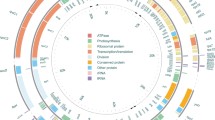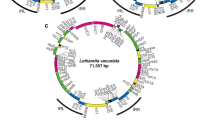Abstract
The single-copy nuclear gene (GapA), encoding the plastid-localized glyceraldehyde-3-phosphate dehydrogenase (GAPDH) of the marine red alga Gracilaria verrucosa, has been cloned and sequenced. The GapA transcriptional initiation site was located 49 bp upstream of the start codon, and a putative TATA box was found 54 bp farther upstream. A spliceosomal intron was identified in the transit-peptide-encoding region in a position very similar to intron 1 of GapA and GapB of higher plants; no introns occur in the region encoding the mature protein. These observations provisionally suggest that both red algae and higher plants descend from a single ancestral photosynthetic eukaryote, i.e. that a single endosymbiotic event gave rise to red algal and higher-plant plastids.
Similar content being viewed by others
References
Bhattacharya D, Elwood HJ, Goff LJ, Sogin ML (1990) Phylogeny of Gracilaria lemaneiformis (Rhodophyta) based on sequence analysis of its small subunit ribosomal RNA coding region. J Phycol 26: 181–186
Bird CJ, Murphy CA, Rice EL, Gutell RR, Ragan MA (1991) Towards an rRNA gene phylogeny of the red algae. J Phycol 27 [suppl]: 9
Branlant C, Oster T, Branlant G (1989) Nucleotide sequence determination of the DNA region coding for Bacillus stearothermophilus glyceraldehyde-3-phosphate dehydrogenase and of the flanking DNA regions required for its expression in Escherichia coli. Gene 75: 145–155
Branlant G, Branlant CH (1985) Nucleotide sequence of the Escherichia coli gap gene. Different evolutionary behavior of the NAD+-binding domain and of the catalytic domain of D-glyceraldehyde-3-phosphate dehydrogenase. Eur J Biochem 150: 61–66
Brinkmann H, Martinez P, Quigley F, Martin W, Cerff R (1987) Endosymbiotic origin and codon bias of the nuclear gene for chloroplast glyceraldehyde-3-phosphate dehydrogenase from maize. J Mol Evol 26: 320–328
Brinkmann H, Cerff R, Salomon M, Soll J (1989) Cloning and sequence analysis of cDNAs encoding the cytosolic precursors of subunits GapA and GapB of chloroplast glyceraldehyde-3-phosphate dehydrogenase from pea and spinach. Plant Mol Biol 13: 81–94
Brown JWS, Feix G, Frendewey D (1986) Accurate in vitro splicing of two pre-mRNA plant introns in a HeLa cell nuclear extract. EMBO J 5: 2749–2758
Cavalier-Smith T (1987) Intron phylogeny: a new hypothesis. Ann NY Acad Sci 503: 55–71
Cerff R (1982) Separation and purification of NAD- and NADP-linked glyceraldehyde-3-phosphate dehydrogenases from higher plants. In: Edelmann M, Hallick RB, Chua N-H (eds) Methods in chloroplast molecular biology. Elsevier Biomedical, Amsterdam, pp 683–694
Cerff R, Kloppstech K (1982) Structural diversity and differential light control of mRNAs coding for angiosperm glyceraldehyde-3-phosphate dehydrogenases. Proc Natl Acad Sci USA 79: 7624–7628
Conway T, Sewell GW, Ingram LO (1987) Glyceraldehyde-3-phosphate dehydrogenase gene from Zymomonas mobilis: cloning, sequencing, and identification of promoter regions. J Bacteriol 169: 5653–5662
Corden J, Wasylyk B, Buchwalder A, Sassone-Corsi P, Kedinger C, Chambon P (1980) Promoter sequences of eukaryotic proteincoding genes. Science 209: 1406–1414
Corpet F (1988) Multiple sequence alignment with hierarchical clustering. Nucleic Acids Res 16: 10881–10890
Craik CS, Rutter WJ, Fletterick R (1983) Splice junctions: association with variation in protein structure. Science 220: 1125–1129
Crane PR, Donoghue MJ, Doyle JA, Friis EM (1989) Angiosperm origins. Nature 342: 131
Dayhoff MO, Schwartz RM, Orcutt BC (1979) In: Dayhoff MO (ed) Atlas of protein sequence and structure, vol 5, suppl 3. Natl Biomed Res Fdn, Silver Spring Md. pp 345–352
Dibb NJ, Newman AJ (1989) Evidence that introns arose at protosplice sites. EMBO J 8: 2015–2021
Doolittle RF (1987) Of URFs and ORFs. A primer on how to analyze derived amino-acid sequences. University Science Books, Mill Valley, California
Doolittle RF, Feng DF, Anderson KL, Alberro MR (1990) A naturally occurring horizontal gene transfer from a eukaryote to a prokaryote. J Mol Evol 31: 383–388
Douglas S (1993) Chloroplast origins and evolution. In: Bryant DA (ed) The molecular biology of the cyanobacteria. Kluwer, Dordrecht (in press)
Douglas SE, Turner S (1991) Molecular evidence for the origin of plastids from a cyanobacterium-like ancestor. J Mol Evol 33: 267–273
Douglas SE, Murphy CA, Spencer DF, Gray MW (1991) Cryptomonad algae are evolutionary chimaeras of two phylogeneticallydistinct unicellular eukaryotes. Nature 350: 148–151
Dover G (1982) Molecular drive: a cohesive mode of species evolution. Nature 299: 111–116
Duion B, Colleaux L, Jacquier A, Michel F, Monteilhet C (1986) Mitochondrial introns as mobile genetic elements: the role of intron-ncoded proteins. In: Wickner RB (ed) Extrachromosomal elements in lower eukaryotes. Plenum Press, New York, pp 5–27
Dynan WS, Tjian R (1985) Control of eukaryotic messenger RNA synthesis by sequence-specific DNA-binding proteins. Nature 316: 774–778
Felsenstein J (1989) PHYLIP — phylogeny inference package (version 3.2). Cladistics 5: 164–166
Finchant GA (1992) Constraints acting on the exon positions of the splice-site sequences and local amino-acid composition of the protein. Hum Mol Genet 1: 259–267
Gibbs SP (1978) The chloroplasts of Euglena may have evolved from symbiotic green algne. Can J Bot 56: 2883–2889
Gil A, Proudfoot NJ (1987) Position-dependent sequence elements downstream of AAUAAA are required for efficient rabbit β-globin mRNA 3′ end formation. Cell 49: 399–406
Gray MW (1992) The endosymbiont hypothesis revisited. Int Rev Cytol 141: 233–357
Gray MW, Doolittle WF (1982) Has the endosymbiont hypothesis been proven. Microbiol Rev 46: 1–42
Hahn S, Hoar ET, Gurennte L (1985) Each of three “TATA elements” specifies a subset of the transcription initiation sites at the CYC-1 promoter of Saccharomyces cerevisiae. Proc Natl Acad Sci USA 82: 8562–8566
Harris JI, Waters M (1976) Glyceraldehyde-3-phosphate dehydrogenase. In: Boyer PD (ed) The enzymes, 3rd edn, vol 13. Academic Press, New York, pp 1–49
Heijne G von, Nishikawa K (1991) Chloroplast transit-peptides. The perfect random coil? FEBS Lett 278: 1–3
Heijne G von, Steppuhn J, Herrmann RG (1989) Domain structure of mitochondrial and chloroplast targeting peptides. Eur J Biochem 180: 535–545
Hendriks L, De Baere R, Van der Peer Y, Neefs J, Goris A, De Wachter R (1991) The evolutionary position of the rhodophyte Porphyra umbilicalis and the basidiomycete Leucosporidium scottii among other eukaryotes as deduced from complete sequences of small ribosomal subunit RNA. J Mol Evol 32: 167–177
Higgins DG, Bleasby AJ, Fuchs R (1992) CLUSTAL V: improved software for multiple sequence alignment. CABIOS 8: 189–191
Hultmark D, Klemenz R, Gehring WJ (1986) Translational and transcriptional control elements in the untranslated leader of the heatshock gene hsp22, Cell 44: 429–438
Iwabe N, Kuma K, Hasegawa M, Osawa S, Miyata T (1989) Evolutionary relationship of archaebacteria, eubacteria and eukaryotes inferred from phylogenetic trees of duplicated genes. Proc Natl Acad Sci USA 86: 9355–9359
Keegstra K, Olsen LJ, Theg SM (1989) Chloroplastic precursors and their transport across the envelope membranes. Annu Rev Plant Physiol Plant Mol Biol 40: 471–501
Lefort-Tran M (1981) The triple layered organization of the Euglena chloroplast envelope (significance and function). Ber Dt Bot Ges 94: 463–476
Lewin RA, Cheng L (1989) Prochloron, a microbial enigma. Chapman and Hall, New York
Li W-H, Gouy M, Wolfe KH, Sharp PM (1989) Angiosperm origins. Nature 342: 131–132
Liaud M-F, Zhang DX, Cerff R (1990) Differential intron loss and endosymbiotic transfer of chloroplast glyceraldehyde-3-phosphate dehydrogenase genes to the nucleus. Proc Natl Acad Sci USA 87: 8918–8922
Lockhart PJ, Howe CJ, Bryant DA, Beanland TJ, Larkum AWD (1992 a) Substitutional bias confounds inference of cyanelle origins from sequence data. J Mol Evol 34: 153–162
Lockhart PJ, Penny D, Hendy MD, Howe CJ, Beanland TJ, Larkum AWD (1992 b) Controversy on chloroplast origins. FEBS Lett 301: 127–131
Martin W, Cerff R (1986) Prokaryotic features of a nucleus-encoded enzyme. cDNA sequences for chloroplast and cytosolic glyceraldehyde-3-phosphate dehydrogenases from mustard (Sinapis alba). Eur J Biochem 159: 323–331
Martin W, Gierl A, Saedler H (1989 a) Molecular evidence for pre-Cretaceous angiosperm origins. Nature 339: 46–48
Martin W, Gierl A, Saedler H (1989 b) Angiosperm origins (reply to Crane et al. and to Li et al.). Nature 342: 132
Martin W, Brinkmann H, Savona C, Cerff R (1993) Evidence for a chimeric nature of nuclear genomes: eubacterial origin of eukaryotic glyceraldehyde-3-phosphate dehydrogenase genes. Proc Natl Acad Sci USA 90: 8692–8696
Martinez P, Martin W, Cerff R (1989) Structure, evolution and anaerobic regulation of a nuclear gene encoding cytosolic glyceraldehyde-3-phosphate dehydrogenase from maize. J Mol Biol 208: 551–565
Mereschowsky C (1905) Über Natur und Ursprung der Chromatophoren im Pflanzenreiche. Biol Centralbl 25: 593–604, 689–691
Mereschowsky C (1910) Theorie der zwei Plamaarten als Grundlage der Symbiogenesis, einer neuen Lehre von der Entstehung der Organismen. Biol Centralbl 30: 278–288, 289–303, 321–347, 354–367
Morden CW, Delwiche CF, Kuhsel M, Palmer JD (1992) Gene phylogenies and the endosymbiotic origin of plastids. BioSystems 28: 75–90
Nierzwicki-Bauer SA, Curtis SE, Haselkorn R (1984) Cotranscription of genes encoding the small and large subunits of ribulose-1,5-hisphosphate carboxylase in the cyanobacterium Anabaena 7120. Proc Natl Acad Sci USA 81: 5961–5965
Palmer JD (1993) A genetic rainbow of plastids. Nature 364: 762–763
Patthy L (1987) Intron-dependent evolution: preferred types of exons and introns. FEBS Lett 214: 1–7
Quigley F, Martin WF, Cerff R (1988) Intron conservation across the prokaryote-eukaryote boundary: structure of the nuclear gene for chloroplast glyceraldehyde-3-phosphate dehydrogenase from maize. Proc Natl Acad Sci USA 85: 2672–2676
Ragan MA, Lee AR III (1992) Making phylogenetic sense of biochemical and morphological diversity among the protists. In: Dudley EC (ed) The unity of evolutionary biology. Dioscorides Press, Portland vol I, pp 432–441
Ragan MA, Bird CJ, Rice EL, Gutell RR, Murphy CA, Singh RK (1994) A molecular phylogeny of the marine red algae (Rhodophyta) based on the nuclear small-subunit rRNA gene. Proc Natl Acad Sci USA 91: in press.
Raven PH (1970) A multiple origin for plastids and mitochondria. Science 169: 641–646
Reith M, Munholland J (1993) A high-resolution gene map of the chloroplast genome of the red alpa Porphyra purpurea. Plant Cell 5: 465–475
Rogers J (1985) Exon shuffling and intron insertion in serine protease genes. Nature 315: 458–459
Sagan L (1967) On the origin of mitosing cell. J Theor Biol 14: 225–274
Sambrook J, Fritsch EF, Maniatis T (1989) Molecular cloning: a laboratory manual, vol 1. Cold Spring Harbor Laboratory, Cold Spring Harbor, New York
Scherer S, Davis RW (1980) Recombination of dispersed repeated DNA sequences in yeast. Science 209: 1380–1384
Schiff JA, Epstein HT (1965) The continuity of the chloroplast in Euglena. In: Locke M (ed) Reproduction: molecular, subcellular and cellular. Academic Press, New York, pp 131–189
Schimper AFW (1883) Über die Entwickelung der Chlorophyllkörner und der Farbkörper. Bot Ztg 41: 105–114
Shih M-C, Lazar G, Goodman HM (1986) Evidence in favor of the symbiotic origin of chloroplasts: primary structure and evolution of tobacco glyceraldehyde-3-phosphate dehydrogenases. Cell 47: 73–80
Smith TL (1989) Disparate evolution of yeasts and filamentous fungi indicated by phylogenetic analysis of glyceraldehyde-3-phosphate dehydrogenase genes. Proc Natl Acad Sci USA 86: 7063–7066
Taylor FJR (1974) Implications and extensions of the serial endosymbiosis theory for the origin of eukaryotes. Taxon 23: 229–258
Wistow G (1993) Protein structure and introns. Nature 364: 107–108
Zhou Y-H, Ragan MA (1993) cDNA cloning and characterization of the nuclear gene encoding chloroplast glyceraldehyde-3-phosphate dehydrogenase from the marine red alga Gracilaria verrucosa. Curr Genet 23: 483–489
Author information
Authors and Affiliations
Additional information
Communicated by R. W. Lee
Rights and permissions
About this article
Cite this article
Zhou, YH., Ragan, M.A. Cloning and characterization of the nuclear gene encoding plastid glyceraldehyde-3-phosphate dehydrogenase from the marine red alga Gracilaria verrucosa . Curr Genet 26, 79–86 (1994). https://doi.org/10.1007/BF00326308
Received:
Accepted:
Issue Date:
DOI: https://doi.org/10.1007/BF00326308




